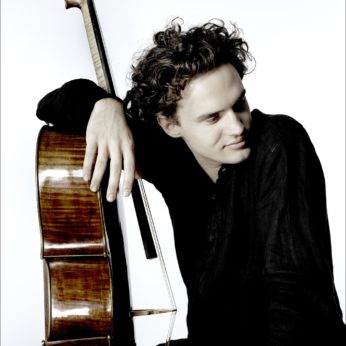Composer: Johannes Brahms (b. 1833 - d. 1897)
Performance date: 30/06/2013
Venue: Bantry Library
Composition Year: 1886
Duration: 00:28:43
Recording Engineer: Damian Chennells, RTÉ lyric fm
Instrumentation: vc, pf
Instrumentation Category:Duo
Artists:
Alexei Grynyuk -
[piano]
Leonard Elschenbroich -
[cello]

Brahms’ Second Cello Sonata was written in
the prime of his life. He was now magnificently in command of every musical
form with the one exception of opera that he had left to his great rival in
Bayreuth. This warm and carefree work dates from the summer of 1886 when he also
wrote the Second Violin Sonata and the Third Piano Trio. Like Mahler after him,
he spent every summer in the Swiss or Austrian mountains walking and composing.
The grandeur of the mountains is in the symphonic sweep of the opening
challenge, where the cello leads with a leaping extrovert theme over a
thunderous tremolando in the piano.
The full range of the cello is exploited and the balance between the
instruments is perfectly judged. The tremolando
becomes a major feature of the mysterious development, its vibrant sonority
adding to the emotional excitement of the movement. Tremolandi in both instruments are a prominent feature of the coda
creating a magical time-stopping effect before the final outburst.
The Adagio
opens with remote piano chords above a pizzicato
bass before the cello gradually blossoms into its heartstoppingly beautiful
melody. As ever he declines the opportunity to overindulge his melodic gift and
the F minor key and the tense re-emergence of the pizzicatos show the passion lurking beneath the melodic surface.
Nonetheless the return of the main theme is one of those moments that melts the
strongest heart and leaves the sentimentally vulnerable quite helpless. The pizzicatos return to dramatic effect in
the coda, each chord reaching that unseen place that only the cello can find,
long after the concert you will still hear the echoes resounding.
From his earliest works Brahms had a
special gift for turbulent, hard-driven Scherzos
and this one shows off his mastery of bracing cross-rhythm and the
interplay of motives. Brahms was of course a virtuoso pianist and for many
years made his living that way, the piano part in this movement was clearly
written for himself, just as the cello part was made for the special luminous
tone of Robert Hausmann. The major key Trio sings in sweeter contrast, giving
us an eloquently simple interlude in the midst of so much passionate ambition.
The Finale is a short cheerful rondo that concludes the work with wit and
grace. The last return of the main theme in the coda is both pizzicato and pianissimo, a typical flourish of Brahmsian humour.
Copyright © 2024 West Cork Music. All rights reserved.
Designed and developed by Matrix Internet